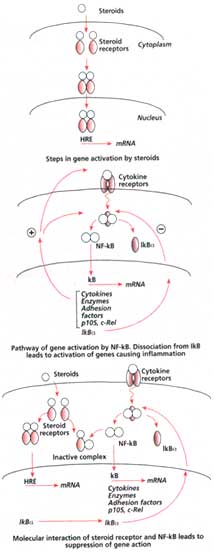Saviour steroids
 cortisone and related chemical compounds - falling in the category known as glucocorticoid or steroid hormones - have a seemingly magical ability to reduce inflammation and suppress the immune system. It is this property that accounts for their wide use in the treatment of many human ailments including asthma, rheumatoid arthritis and allergic conditions. Quite apart from their medicinal use, steroids function similarly under natural conditions. For example, the sex steroid progesterone is involved in suppressing the rejection of the foetus by the maternal immune system.
cortisone and related chemical compounds - falling in the category known as glucocorticoid or steroid hormones - have a seemingly magical ability to reduce inflammation and suppress the immune system. It is this property that accounts for their wide use in the treatment of many human ailments including asthma, rheumatoid arthritis and allergic conditions. Quite apart from their medicinal use, steroids function similarly under natural conditions. For example, the sex steroid progesterone is involved in suppressing the rejection of the foetus by the maternal immune system.
The initial step of steroid action is reasonably well understood today. The hormone first binds to a protein molecule within the target cell known as a receptor, and the hormone-receptor 'complex' migrates to the nucleus and interacts with a specific region of the cell's genetic machinery, its dna.The receptors have more than one functional unit or 'domain': there is a domain for binding the hormone, another for binding dna and a third for influencing gene expression. It was believed that gene expression was usually activated by steroid hormones, but it turns out that one can also get repression. Repression can occur when the steroid hormone binds to, and so inactivates, yet another protein called a transcription factor. Glucocorticoid receptors are present throughout the body, which makes them ideal as general anti-inflammatory drugs.
This brings us to the second part of our story, which concerns a transcription factor called nf-k b. Normally, nf-k b is present in the cell in an inactive form. When activated (by bacterial or viral proteins, or by other inflammation-causing agents) it moves to the cell nucleus and also binds to dna. Binding of nf-k b to dna induces the transcription of a variety of genes whose products play a major role in immunological and inflammatory processes.
Do steroid hormone receptors and nf -k b have anything to do with each other? Yes, say P T van Der Saag and his colleagues at the Netherlands Institute for Developmental Biology in Utrecht. The thesis of this group, backed up by a series of complex experiments, propounds that nf -k b and the glucocorticoid or progesterone receptor mutually suppress each other's activities. Such suppression would provide a convenient explanation for the anti-inflammatory and immuno-suppressive role of steroid hormones. Let us examine the interplay in some detail (Molecular Human Reproduction, Vol 2, No 6, and Molecular Endocrinology, Vol 9, No 4).
nf-kbis normally found associated with an inhibitory molecule, ikb. Upon activation, ikb is released and rapidly degraded. nf-kb then moves to the nucleus where it forms a dimer (a combination of two subunits) composed of molecules known as nfkb1 and rela, both of which can bind to dna. Van Der Saag's group and others have shown that there is a direct protein-protein interaction between rela and the glucocorticoid receptor (gr). This interaction causes a repression of the (normal) stimulation of gene expression that r el a and gr are capable of causing independently. In short, rela inhibits gr and vice versa.
Similarly, there is a mutual inhibition between the progesterone receptor (pr) and rela. In addition to such direct interactions, yet another possible mechanism for the suppression of nf-kb relies on the induction of ikb (the molecule that inhibits nf-kb) by glucocorticoids.
In summary, as the paper by van Der Saag puts it, the finding that steroid hormones can repress the activity of nf-kb "gives a simple and plausible explanation for the strong immuno-suppressive and anti-inflammatory activity of these hormones. Particularly, the female reproductive organs are subject to strong hormonally directed changes which are cyclically terminated by inflammation-like processes. Therefore, the balance between nf-kb and the progesterone receptor may be important in regulating processes including menstruation, ovulation and parturition".
